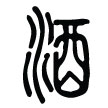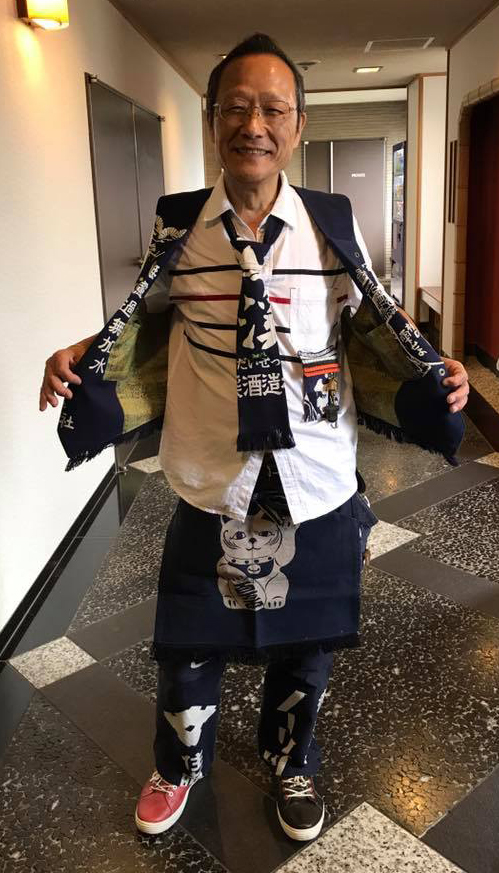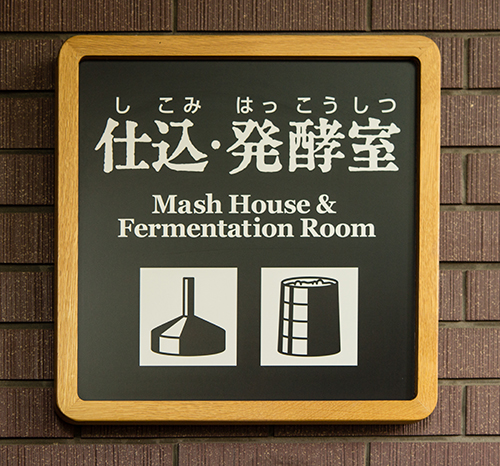164. The "Saké" Radical: 酉
The "saké" radical 酉 has a split personality. On the one hand, as one would expect from the English name, this radical involves alcohol. Booze clearly streams into the definitions of these kanji:
酒 (302: alcohol; saké)
酵 (1265: fermentation)
酌 (1343: to serve or drink alcohol; consideration for others)
醸 (1425: to brew, distill; cause)
酔 (1457: intoxication; fascination; motion sickness)
酎 (2066: shochu)
Regarding the last definition, "shochu" is a distilled liquor made from sweet potatoes, barley, wheat, or rice.
It makes sense to find "spirits" in these six characters. After all, Henshall says that 酉 is the pictograph of a "wine jar" and symbolizes "alcohol" in general.
This is what 酒 (302: alcohol; saké) used to look like:

In an etymology of this character, Henshall says that the "water" radical 氵 indicates "liquid" and that 酒 therefore represents "liquid in wine jar," which is to say "alcohol." In Japan, he notes, "saké" is another possible definition of 酒.
This seal-script image of 酒 (courtesy of Richard Sears) shows that the character has barely changed over the years. However, 氵has replaced what used to resemble a curving river. In this context, those wavy lines look like alcohol fumes rising from a drunk person in a cartoon!

Photo Credit: Glennis Dolce
This man takes vintage shopkeeper aprons and turns them into accessories! On his tie, the 酒造
(しゅぞう: saké brewing) appears to be part of the brewery name 大雪渓酒造 (だいせっけいしゅぞう).
Does 酉 Always Bring Alcohol Into Kanji?
It may be too restrictive to say that 酉 brings alcohol into kanji. Nelson gives a broader interpretation, saying that the 酉 radical connotes "liquid." That could explain why these nonalcoholic liquids contain that radical:
酢 (1300: vinegar)
酪 (1891: dairy product)
Of course, vinegar is often made by fermenting alcohol, so in that way 酢 connects to the alcoholic theme. Henshall confirms that in 酢, the radical means "wine" and the 作 means "to make" (also phonetically expressing "passage of time"). Thus, 酢 is "that which is made from wine with the passage of time"—namely, "vinegar"! How cool is that?!
As for 酪, Henshall says in his newer edition that the radical in this case means "wine jar" and indicates "fermentation." The 各 (usually "each, every") apparently acts phonetically here to express “sour.” He cites an ancient Chinese dictionary that defines 酪 as “milk made into a thick paste.” And he says that two scholars take this as referring to milk products made into a drink or into cheese.
Photo Credit: Eve Kushner
A menu in Kobe features our radical twice in a short space! We see it in the third column from the left in 酒 (さけ).
In the second column from the left, we find 酢 (vinegar) in 蛸酢 (たこす). The non-Joyo 蛸 breaks down as "insect" + "likeness" but somehow means "octopus"! Thus, 蛸酢 is probably a dish containing vinegared octopus and vegetables. People usually call that dish タコの酢の物 (タコのすのもの).
Here are the other items on the menu:
玉子焼 (たまごやき: rolled egg; rolled omelet)
五目焼 (ごもくやき), which may be short for 五目玉子焼き (ごもくたまごやき: omelet with five ingredients) or 五目焼きそば (ごもくやきそば: fried noodles with five ingredients), though it's unclear
ぎょうざ (crescent-shaped pan-fried dumplings stuffed with minced pork and vegetables)
付出し (つきだし: appetizer), a term usually rendered as 突き出し
The prices at the bottom make me realize that the kanji 四 (four) looks a lot like our 酉 radical.
What Do the Japanese Call the 酉 Radical?
The Japanese name for the 酉 radical presents us with the other side of its personality, and dare I say that it's a radically different side?! Here's what I mean. Nelson calls the radical とり. That reading comes from the yomi of the autonomous non-Joyo kanji 酉:
酉 (とり: 10th sign of the Chinese zodiac (The Bird); 5 p.m.–7 p.m.; west; August)
The name とり applies to any kanji featuring this radical. If it's on the left side of a character, as it is in every Joyo kanji except 酒, then this more specific name works:
とりへん (酉偏) zodiacal bird + left-side radical
Here are three examples of our radical on the left:
酸 (689: acid; oxygen; sour)
酷 (1273: severe, cruel, intense)
醒 (2041: to awaken)
There's nothing alcoholic or avian about these definitions, though "acid" and "sour" may toe the line.
The zodiacal bird that 酉 represents is a rooster. Although the Japanese term for your garden-variety rooster is 雄鶏 (おんどり), the zodiacal rooster has its own kanji, as many zodiacal creatures do.
As I explain on page 175 of Crazy for Kanji, the zodiacal system comes from ancient China and is quite complicated, involving several religions and an ancient Chinese system of clocks and compass directions. That's why we see "5 p.m.–7 p.m." and "west" as definitions of 酉. As for "August," the complex system also involves the lunar calendar.
Two more names for the radical stay firmly in the realm of the zodiac and calendar:
ひよみのとり (日読の酉) day + reading + zodiacal bird
こよみのとり (暦の酉) calendar, almanac + zodiacal bird
These terms allude to the role that 酉 plays in the zodiac. Specifically, says Nelson, ひよみのとり (日読の酉) means "bird of the zodiac," though 日読 more specifically refers to the calendar, literally meaning "reading the days."
The reason to emphasize that 酉 is a zodiacal bird is to distinguish it from the ordinary bird kanji 鳥.
With 酉, one also needs to specify what kind of とり it is because there are two other "bird" radicals, and とり recurs in those names:
radical 172: 隹, the "old bird" radical (read as ふるとり, which literally means "old bird")
radical 196: 鳥, the "bird" radical (read as とり, とりへん, or とりつくり)
It's easy to associate 隹 and 鳥 with birds because they mean that in so many contexts. By contrast, it's a challenge (at least for me) to look at 酉 and to remember the bird connection and therefore the とり yomi while the shape instead brings up thoughts of saké.
The Japanese do in fact have ways of reading 酉 that reflect the alcohol connection:
さけづくり (酒旁) saké + right-side radical
さけのとり (酒の酉) saké + radical 164
Perhaps it's more accurate to say that both terms reflect the way the Japanese associate 酉 with the 酒 kanji. The radical name 酒旁 means "the radical on the right side of the saké kanji." And 酒の酉 means "the 酉 radical in 酒." Notice that the yomi さけのとり includes both saké and birds. This is therefore the only Japanese term to bridge the enormous alcohol-avian divide.
By the way, here are three English terms for the 酉 radical: "saké," "wine jug," and "zodiac sign of the bird."

Photo Credit: Samuel
The sign couldn't be much clearer, at least by Japanese standards. The kanji are legible, and they come with furigana and an overall translation. Here's what the individual words mean:
仕込 (しこみ: preparation (e.g., of ingredients)) doing + going inward
発酵室 (はっこうしつ: fermentation room) fermentation (1st 2 kanji) + room
Our radical appears here in 酵 (1265: fermentation).
What About the Resemblance Between 酒 and 西?
I mentioned that the autonomous kanji 酉 could mean "west." And that may have made you wonder about this autonomous kanji:
西 (152: west)
After all, it looks almost exactly like the seven-stroke 酉, except for a missing horizontal line toward the bottom of 西. Are any of these overlaps significant?
I don't think so, but 西 may have a connection to alcohol. Henshall says that 西 originally had a different shape and represented a "basket" used as a crude wine press. The whole character phonetically expresses "west" but, he says, the depiction of falling drops of wine also lends a suggestion of "falling (sun)." By contrast, the etymology in Kanjigen has nothing to do with wine. That source says that 西 originally represented a basket that leaked water. Then somehow it became sunlight that was leaking out. And 西 came to mean "the direction in which sunlight leaks," which is to say "west."
The biggest surprise for me is that the radical of 西 isn't 酉 but is instead this:
radical 146: 襾, the "west" radical
So whereas we need to differentiate radicals 164 and from 172 and 196 based on their yomi and bird aspects, we need to differentiate radical 164 from kanji 152 (and kind of from radical 146) based on their shapes.
Photo Credit: Eve Kushner
Alcohol as far as the eye can see! Our radical pops up twice here. In the dark bottles, it appears in 醸 (1425: to brew), which is in this term:
大吟醸 (だいぎんじょう: top-quality saké brewed from rice grains milled to 50 percent) big + to taste deeply + brewing
The first word on that bottle, 山田錦 (やまだにしき), is the name of a short-grain rice that's famously used in high-quality saké.
The lowest bottles end with 酒. The word 生原酒 (なまげんしゅ) can either be a brand name or a type of saké.
